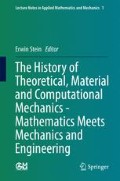Abstract
After a brief review on the development of three mathematical models in the history of mechanics, we outline today’s role of parameter identification within the process of model building. On this basis, parameter identification is illustrated as a direct method by hand-fitting for some simple mathematical structures from the early stages of mathematical modeling. The beginning of so called “advanced constitutive modeling” in the sixties of the twentieth century rendered parameter identification as a least-squares problem. For its solution evolution strategies and more efficient optimization algorithms have been introduced by several researchers. After addressing these developments, we will also outline some newer aspects such as inhomogeneous field problems and stochastic methods.
Access this chapter
Tax calculation will be finalised at checkout
Purchases are for personal use only
Preview
Unable to display preview. Download preview PDF.
References
Andresen, K., Dannemeyer, S., Friebe, H., Mahnken, R., Ritter, R., Stein, E.: Parameteridentifikation für ein plastisches Stoffgesetz mit FE-Methoden und Rasterverfahren. Der Bauingenieur 71, 21–31 (1996)
Bard, Y.: Nonlinear Parameter Estimation. Academic Press, New York (1974)
Beck, J.V., Arnold, K.J.: Parameter Estimation in Engineering and Science. Wiley, New York (1977)
Becker, R., Vexler, B.: Mesh refinement and numerical sensitivity analysis for parameter calibration of partial differential equations. J. Comput. Phys. 206(1), 95–110 (2005)
Cavendish, H. (1798) Experiments to Determine the Density of the Earth. In: MacKenzie, A.S. (ed.) Scientific Memoirs, vol. 9, pp. 59–105. The Laws of Gravitation, American Book Co (1900)
Dennis, J.E., Schnabel, R.B.: Numerical Methods for Unconstrained Optimization and Nonlinear Equations. Prentice Hall, New Jersey (1983)
Larsson, F., Hansbo, P., Runesson, K.: Strategies for computing goal-oriented a posteriori error measures in non-linear elasticity. Int. J. Numer. Meth. Engng. 55(8), 879–894 (2002)
Lemaitre, J., Chaboche, J.L.: Mechanics of solid Materials. Cambridge University Press, Cambridge (1990)
Luenberger, D.G.: Linear and nonlinear programming, 2nd edn. Addison-Wesley, Reading (1984)
Mahnken, R., Stein, E.: The identification of parameters for visco-plastic models via finite-element-methods and gradient-methods. Modelling and Simulation Material Science and Engineering 2(3A), 597–614 (1994)
Mahnken, R., Stein, E.: Parameter identification for finite deformation elasto-plasticity in principal directions. Comp. Meths. Appl. Mech. Eng. 147, 17–39 (1997)
Mohr, R.: Modellierung des Hochtemperaturverhaltens metallischer Werkstoffe. Dissertation, Report GKSS 99/E/66, GKSS Research Center, Geesthacht (1999)
Neal, B.G.: Structural Theorems and their Applications. Pergamon Press (1964)
Press, W.H., Teukolsky, S.A., Vetterling, W.T., Flannery, B.P.: Numerical Recipes in Fortran. Cambridge University Press (1992)
Quagliarella, D., Vicini, A.: Coupling genetic algorithms and gradient based optimization techniques. In: Quagliarella, D., et al. (eds.) Genetic Algorithms and Evolution Strategies in Engineering and Computer Science, pp. 289–309. Wiley, Chichester (1997)
Rechenberg, I.: (1971) Evolutionsstrategie - Optimierung technischer Systeme nach Prinzipien der biologischen Evolution (PhD thesis). Reprinted by Fromman-Holzboog (1973)
Rechenberg, I.: Evolutionsstrategie 1994. Frommann-Holzboog, Stuttgart (1994)
Schwan, S.: Identifikation der Parameter inelastischer Werkstoffmodelle: Statistische Analyse und Versuchsplanung. Shaker Verlag, Aachen (2000)
Nörenberg, N., Mahnken, R.: A stochastic model for parameter identification. Arch. Appl. Mech. (2012), doi:10.1007/s00419-012-0684-7
Schwefel, K.P.: Numerische Optimierung von Computer-Modellen mittels der Evolutionsstrategie. Birkhäuser Verlag, Basel (1977)
Senseny, P.E., Brodsky, N.S., De Vries, K.L.: Parameter Evaluation for a Unified Constitutive Model. Transactions of the ASME: J. Eng. Mat. Tech. 115, 157–162 (1993)
Steck, E.: A Stochastic Model for the Interaction of Plasticity and Creep in Metals. Nuclear Engineering and Design 114, 285–294 (1989)
Steck (ed.): Collaborative Research Centre 319 (SFB 319), Stoffgesetze für das inelastische Verhalten metallischer Werkstoffe, Entwicklung und technische Anwendung, Arbeitsbericht 1991/92/93 (1993)
Strathern, P.: Newton und die Schwerkraft. Fischer Taschenbuch Verlag (1998)
Szabo, I.: Geschichte der mechanischen Prinzipien, 3. Birkhäuser Verlag, Auflage (1987)
Terzaghi, C.: Principles of Soil Mechanics: II-Compressive Strength of Clay (1998); Engineering News-Record 95(20) (1925)
Timoshenko, S.P.: History of Strength of Materials (1983)
Vexler, B.: Adaptive Finite Element Methods for Parameter Identification Problems. Dissertation, University of Heidelberg (2004)
Wedemeier, T.: Beiträge zur Theorie und Numerik von Materialien mit innerer Reibung am Beispiel des Werkstoffes Beton, Dissertation, University of Hannover (1990)
Widany, K.U., Mahnken, R.: Adaptivity for parameter identification of incompressible hyperelastic materials using stabilized tetrahedral elements. Comput. Methods Appl. Mech. Engrg. 245-246, 117–131 (2012)
Author information
Authors and Affiliations
Corresponding author
Editor information
Editors and Affiliations
Rights and permissions
Copyright information
© 2014 Springer-Verlag Berlin Heidelberg
About this chapter
Cite this chapter
Mahnken, R. (2014). Parameter Identification in Continuum Mechanics: From Hand-Fitting to Stochastic Modelling. In: Stein, E. (eds) The History of Theoretical, Material and Computational Mechanics - Mathematics Meets Mechanics and Engineering. Lecture Notes in Applied Mathematics and Mechanics, vol 1. Springer, Berlin, Heidelberg. https://doi.org/10.1007/978-3-642-39905-3_14
Download citation
DOI: https://doi.org/10.1007/978-3-642-39905-3_14
Publisher Name: Springer, Berlin, Heidelberg
Print ISBN: 978-3-642-39904-6
Online ISBN: 978-3-642-39905-3
eBook Packages: EngineeringEngineering (R0)

